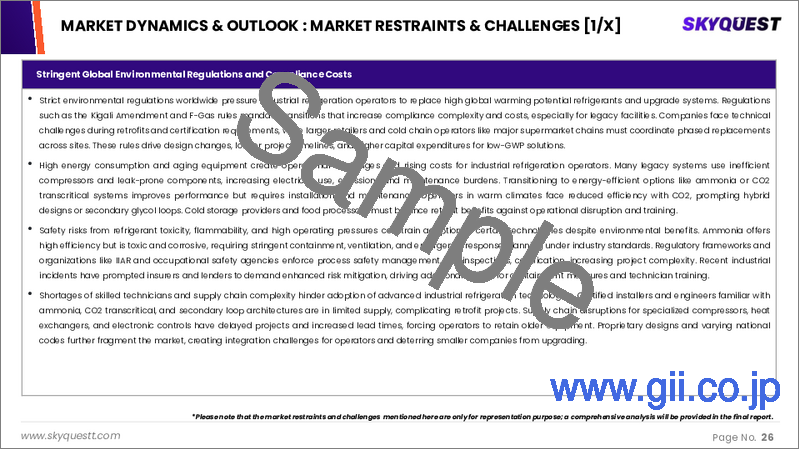|
|
市場調査レポート
商品コード
1670707
産業用冷凍機の市場規模、シェア、成長分析:コンポーネント別、冷媒の種類別、用途別、地域別 - 産業予測 2025~2032年Industrial Refrigeration Market Size, Share, and Growth Analysis, By Component (Compressor, Condenser), By Refrigerant Type (Ammonia, CO2), By Application, By Region - Industry Forecast 2025-2032 |
||||||
|
|||||||
| 産業用冷凍機の市場規模、シェア、成長分析:コンポーネント別、冷媒の種類別、用途別、地域別 - 産業予測 2025~2032年 |
|
出版日: 2025年02月27日
発行: SkyQuest
ページ情報: 英文 162 Pages
納期: 3~5営業日
|
全表示
- 概要
- 目次
産業用冷凍機の世界市場規模は2023年に215億米ドルと評価され、2024年の225億3,000万米ドルから2032年には327億9,000万米ドルに成長し、予測期間(2025-2032年)のCAGRは4.8%で成長する見通しです。
産業用冷凍機市場は、小型冷凍ユニットに対する需要の高まりと、新興国におけるコールドチェーンインフラの強化に対する政府の後押しの増加により、力強い成長を遂げています。厳しい規制により環境に優しい冷凍ソリューションが重視されるようになっていることが、この成長をさらに後押ししています。加工食品や飲食品の消費が増加するにつれ、腐敗を防ぐための効率的な冷蔵ソリューションの必要性がますます高まっています。この動向は、地球温暖化の懸念によってさらに悪化し、メーカーに自然冷媒へのシフトを促しています。さらに、オンライン食料品販売の拡大や、農場レベルでの食品ロスを最小限に抑える必要性が、特に飲食品、小売、化学薬品などのセクターにおいて、農業気候条件が変化する中で、高度なコールドチェーン技術への投資を促進しています。
目次
イントロダクション
- 調査の目的
- 調査範囲
- 定義
調査手法
- 情報調達
- 二次と一次データの方法
- 市場規模予測
- 市場の前提条件と制限
エグゼクティブサマリー
- 世界市場の見通し
- 供給と需要の動向分析
- セグメント別機会分析
市場力学と見通し
- 市場概要
- 市場規模
- 市場力学
- 促進要因と機会
- 抑制要因と課題
- ポーターの分析
主な市場の考察
- 重要成功要因
- 競合の程度
- 主な投資機会
- 市場エコシステム
- 市場の魅力指数(2024年)
- PESTEL分析
- マクロ経済指標
- バリューチェーン分析
- 価格分析
産業用冷凍機市場規模:コンポーネント別& CAGR(2025-2032)
- 市場概要
- コンプレッサー
- コンデンサー
- 蒸発器
- 制御
- 容器ポンプ
- バルブ
- 補助装置
産業用冷凍機市場規模:冷媒の種類別& CAGR(2025-2032)
- 市場概要
- アンモニア
- 二酸化炭素
- その他
- HFC
- HCFC
- HFO
- HC
産業用冷凍機市場規模:用途別& CAGR(2025-2032)
- 市場概要
- 冷蔵倉庫
- 果物と野菜の加工
- 飲料加工
- 化学石油化学医薬品
- 乳製品およびアイスクリーム加工
- 肉鶏肉魚の加工
- 冷蔵輸送
産業用冷凍機市場規模:地域別& CAGR(2025-2032)
- 北米
- 米国
- カナダ
- 欧州
- ドイツ
- スペイン
- フランス
- 英国
- イタリア
- その他欧州地域
- アジア太平洋地域
- 中国
- インド
- 日本
- 韓国
- その他アジア太平洋地域
- ラテンアメリカ
- ブラジル
- その他ラテンアメリカ地域
- 中東・アフリカ
- GCC諸国
- 南アフリカ
- その他中東・アフリカ
競合情報
- 上位5社の比較
- 主要企業の市場ポジショニング(2024年)
- 主な市場企業が採用した戦略
- 最近の市場動向
- 企業の市場シェア分析(2024年)
- 主要企業の企業プロファイル
- 企業の詳細
- 製品ポートフォリオ分析
- 企業のセグメント別シェア分析
- 収益の前年比比較(2022-2024)
主要企業プロファイル
- Danfoss(Denmark)
- Johnson Controls(Ireland)
- Emerson Electric(USA)
- GEA Group(Germany)
- Bitzer(Germany)
- Mayekawa(Japan)
- Frick(USA)
- Star Refrigeration(UK)
- Baltimore Aircoil Company(USA)
- Evapco(USA)
- Carnot Refrigeration(Canada)
- Parker Hannifin(USA)
- Alfa Laval(Sweden)
- Tecnofreddo(Italy)
- Vilter Manufacturing(USA)
- Guntner(Germany)
- Hansen Technologies(Canada)
- Witt(Germany)
- RefPlus(Canada)
- Arctica Technologies(Canada)
結論と提言
Global Industrial Refrigeration Market size was valued at USD 21.5 billion in 2023 and is poised to grow from USD 22.53 billion in 2024 to USD 32.79 billion by 2032, growing at a CAGR of 4.8% during the forecast period (2025-2032).
The industrial refrigeration market is experiencing robust growth driven by rising demand for compact refrigeration units and increased government backing to enhance cold chain infrastructure in developing nations. The growing emphasis on environmentally friendly refrigeration solutions due to stringent regulations is further fueling this growth. As consumption of processed and packaged food and beverages rises, the need for efficient cold storage solutions to prevent spoilage becomes increasingly critical. This trend is further exacerbated by global warming concerns, prompting manufacturers to shift towards natural refrigerants. Additionally, the expansion of online grocery sales and the necessity to minimize food loss at the farm level are propelling investment in advanced cold chain technologies, especially in sectors like food and beverage, retail, and chemicals, amid changing agro-climatic conditions.
Top-down and bottom-up approaches were used to estimate and validate the size of the Global Industrial Refrigeration market and to estimate the size of various other dependent submarkets. The research methodology used to estimate the market size includes the following details: The key players in the market were identified through secondary research, and their market shares in the respective regions were determined through primary and secondary research. This entire procedure includes the study of the annual and financial reports of the top market players and extensive interviews for key insights from industry leaders such as CEOs, VPs, directors, and marketing executives. All percentage shares split, and breakdowns were determined using secondary sources and verified through Primary sources. All possible parameters that affect the markets covered in this research study have been accounted for, viewed in extensive detail, verified through primary research, and analyzed to get the final quantitative and qualitative data.
Global Industrial Refrigeration Market Segments Analysis
Global Industrial Refrigeration Market is segmented by Component, Refrigerant Type, Application and region. Based on Component, the market is segmented into Compressor, Condenser, Evaporator, Control, Vessel Pump, Valves and Auxiliary Equipment. Based on Refrigerant Type, the market is segmented into Ammonia, CO2 and Others. Based on Application, the market is segmented into Refrigerated Warehouses, Fruit And Vegetable Processing, Beverage Processing, Chemical, Petrochemical, and Pharmaceutical, Dairy And Ice Cream Processing, Meat, Poultry, and Fish Processing and Refrigerated Transportation. Based on region, the market is segmented into North America, Europe, Asia Pacific, Latin America and Middle East & Africa.
Driver of the Global Industrial Refrigeration Market
The growing adoption of variable speed compressors is a significant driver in the Global Industrial Refrigeration market. These innovative compressors enhance energy efficiency by allowing adjustments to operational speeds based on varying load demands, thus optimizing energy consumption and reducing costs. Businesses are increasingly recognizing the benefits of these advanced systems, as they not only minimize energy waste but also contribute to sustainability efforts by lowering greenhouse gas emissions. As industries strive for more efficient and eco-friendly cooling solutions, the shift towards variable speed technologies is expected to accelerate, driving further growth and advancements within the industrial refrigeration sector.
Restraints in the Global Industrial Refrigeration Market
One of the significant constraints facing the global industrial refrigeration market is the high energy consumption and associated operating costs. These systems often require substantial amounts of energy to function efficiently, leading to increased electricity bills and overall operational expenses for businesses. As industries strive to enhance energy efficiency and reduce environmental impact, the financial burden of high energy consumption could deter investment in traditional refrigeration solutions. Additionally, rising energy prices worldwide may further exacerbate these challenges, pushing companies to seek more sustainable and cost-effective alternatives that can deliver the necessary performance without compromising their bottom line.
Market Trends of the Global Industrial Refrigeration Market
The Global Industrial Refrigeration market is increasingly pivoting towards green refrigeration technologies, marking a significant transformation driven by sustainability concerns. This trend features the adoption of energy recovery systems, waste heat utilization, and the implementation of sustainable design principles, particularly the shift towards environmentally friendly refrigerants. As industries strive to align with global sustainability goals and reduce their ecological footprint, these innovations not only mitigate environmental impact but also enhance energy efficiency. This market evolution supports the broader transition towards a circular economy, promising a future where industrial operations prioritize environmental responsibility while maintaining operational effectiveness.
Table of Contents
Introduction
- Objectives of the Study
- Scope of the Report
- Definitions
Research Methodology
- Information Procurement
- Secondary & Primary Data Methods
- Market Size Estimation
- Market Assumptions & Limitations
Executive Summary
- Global Market Outlook
- Supply & Demand Trend Analysis
- Segmental Opportunity Analysis
Market Dynamics & Outlook
- Market Overview
- Market Size
- Market Dynamics
- Drivers & Opportunities
- Restraints & Challenges
- Porters Analysis
- Competitive rivalry
- Threat of substitute
- Bargaining power of buyers
- Threat of new entrants
- Bargaining power of suppliers
Key Market Insights
- Key Success Factors
- Degree of Competition
- Top Investment Pockets
- Market Ecosystem
- Market Attractiveness Index, 2024
- PESTEL Analysis
- Macro-Economic Indicators
- Value Chain Analysis
- Pricing Analysis
Global Industrial Refrigeration Market Size by Component & CAGR (2025-2032)
- Market Overview
- Compressor
- Condenser
- Evaporator
- Control
- Vessel Pump
- Valves
- Auxiliary Equipment
Global Industrial Refrigeration Market Size by Refrigerant Type & CAGR (2025-2032)
- Market Overview
- Ammonia
- CO2
- Others
- HFC
- HCFC
- HFO
- HC
Global Industrial Refrigeration Market Size by Application & CAGR (2025-2032)
- Market Overview
- Refrigerated Warehouses
- Fruit And Vegetable Processing
- Beverage Processing
- Chemical, Petrochemical, and Pharmaceutical
- Dairy And Ice Cream Processing
- Meat, Poultry, and Fish Processing
- Refrigerated Transportation
Global Industrial Refrigeration Market Size & CAGR (2025-2032)
- North America (Component, Refrigerant Type, Application)
- US
- Canada
- Europe (Component, Refrigerant Type, Application)
- Germany
- Spain
- France
- UK
- Italy
- Rest of Europe
- Asia Pacific (Component, Refrigerant Type, Application)
- China
- India
- Japan
- South Korea
- Rest of Asia-Pacific
- Latin America (Component, Refrigerant Type, Application)
- Brazil
- Rest of Latin America
- Middle East & Africa (Component, Refrigerant Type, Application)
- GCC Countries
- South Africa
- Rest of Middle East & Africa
Competitive Intelligence
- Top 5 Player Comparison
- Market Positioning of Key Players, 2024
- Strategies Adopted by Key Market Players
- Recent Developments in the Market
- Company Market Share Analysis, 2024
- Company Profiles of All Key Players
- Company Details
- Product Portfolio Analysis
- Company's Segmental Share Analysis
- Revenue Y-O-Y Comparison (2022-2024)
Key Company Profiles
- Danfoss (Denmark)
- Company Overview
- Business Segment Overview
- Financial Updates
- Key Developments
- Johnson Controls (Ireland)
- Company Overview
- Business Segment Overview
- Financial Updates
- Key Developments
- Emerson Electric (USA)
- Company Overview
- Business Segment Overview
- Financial Updates
- Key Developments
- GEA Group (Germany)
- Company Overview
- Business Segment Overview
- Financial Updates
- Key Developments
- Bitzer (Germany)
- Company Overview
- Business Segment Overview
- Financial Updates
- Key Developments
- Mayekawa (Japan)
- Company Overview
- Business Segment Overview
- Financial Updates
- Key Developments
- Frick (USA)
- Company Overview
- Business Segment Overview
- Financial Updates
- Key Developments
- Star Refrigeration (UK)
- Company Overview
- Business Segment Overview
- Financial Updates
- Key Developments
- Baltimore Aircoil Company (USA)
- Company Overview
- Business Segment Overview
- Financial Updates
- Key Developments
- Evapco (USA)
- Company Overview
- Business Segment Overview
- Financial Updates
- Key Developments
- Carnot Refrigeration (Canada)
- Company Overview
- Business Segment Overview
- Financial Updates
- Key Developments
- Parker Hannifin (USA)
- Company Overview
- Business Segment Overview
- Financial Updates
- Key Developments
- Alfa Laval (Sweden)
- Company Overview
- Business Segment Overview
- Financial Updates
- Key Developments
- Tecnofreddo (Italy)
- Company Overview
- Business Segment Overview
- Financial Updates
- Key Developments
- Vilter Manufacturing (USA)
- Company Overview
- Business Segment Overview
- Financial Updates
- Key Developments
- Guntner (Germany)
- Company Overview
- Business Segment Overview
- Financial Updates
- Key Developments
- Hansen Technologies (Canada)
- Company Overview
- Business Segment Overview
- Financial Updates
- Key Developments
- Witt (Germany)
- Company Overview
- Business Segment Overview
- Financial Updates
- Key Developments
- RefPlus (Canada)
- Company Overview
- Business Segment Overview
- Financial Updates
- Key Developments
- Arctica Technologies (Canada)
- Company Overview
- Business Segment Overview
- Financial Updates
- Key Developments





